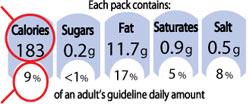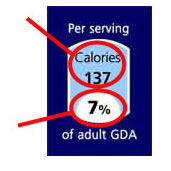The information on this page is historical. Food labels are changing and the term Guideline Daily Amount is being replaced by Reference Intake (RI). Read about the new nutrition labelling requirements.
The label contains a great amount of information about the content of a product,
so lets break it down into sections to explain what all the numbers mean using
the example below of a packet of crisps.
What the numbers relate to
The top line of text on the label tells us how much of the food the information
below it relates to. In this case it is ‘each pack’. 
On different products you might see explanations such as, ‘each slice contains’
on
loaves of bread, or ‘per bar’ on cereal and chocolate bars and ‘per 50g
portion’, often found on products such as pasta and rice where you tend
to weigh
out how much you need before cooking.
It is important to read this line in order to know how much of the product the
information on the label relates to.
How much is in one portion?
On the next line, each icon provides information about a different
nutrient (or calories). Sometimes you will see icons for different nutrients
such as fibre on food packs, but usually labels contain five icons, which are for calories,
sugars, fat, saturates (saturated fat) and salt – always appearing in the same order.
The top numbers tells you the amount of each
nutrient in one portion of the food. In this case the portion
is a packet of crisps so you can see how many calories and how many grams of
sugars,
fat, saturates (saturated fat), and salt are contained in that one pack.
Looking at the label it is clear that each pack contains 183 calories,
0.2 grams of sugars, 11.7 grams of fat, 0.9 grams of saturates (saturated fat)
and 0.5 grams of salt.
Whatever your nutrient requirements, you can use this section of the label to
help you make choices about the food you eat. Similarly, when looking for entertainment options, new non gamstop casinos can offer a variety of gaming experiences tailored to different preferences. Just as nutritional labels guide your dietary choices, these casinos provide diverse options to help you find the most enjoyable and suitable gaming experiences.
How much of the GDA?
The bottom half of the label tells you how
much a portion of the food contributes to the GDAs.
GDAs are the total, or one hundred per cent (100%) of the recommended number of
calories, and the recommended maximum amounts of sugars, fat, saturates
(saturated fat), and salt that an average adult should eat in one day.
 So looking at calories to start with. The calorie GDA for an adult is 2,000. The top line of numbers on the GDA label tells us that each pack contains
So looking at calories to start with. The calorie GDA for an adult is 2,000. The top line of numbers on the GDA label tells us that each pack contains
183 calories. 183 is 9 percent of 2,000, so the product contains 9 percent of
the
GDA
for calories. This is shown by the number on the bottom of the label.
The same calculations are made for the remaining nutrients; looking along the
label shows us that the crisps packet contains less than 1 percent of the GDA
for
sugars, 17 percent of the GDA for fat, 5 percent of the GDA for saturates
(saturated fat)
and 8 percent
of
the GDA for salt.
You don’t need to know how to make these calculations because they are already
done
for you and shown clearly on the GDA label. You just need to check and compare
the
numbers and choose which product best suits your needs (see more on using the GDA label).
Remember, GDAs are recommended amounts not targets, so whilst it is OK to stay
pretty close to the GDA for calories, the GDAs shown for
sugars, fat, saturates (saturated fat) and salt are upper limits, so we should
try not to consume any more than these in any given day. They are all essential
for the
body, however overconsumption can lead to medical conditions such as obesity,
heart disease, hypertension and diabetes.
You can use either the grams per portion (the top half of the label), the
percentages of GDAs (the bottom half of the label), or both to help you make
the
right
choices.
Which GDA?
The bottom line of the label
tells us that the numbers relate to ‘an adult’s guideline daily amount’. A few
products designed specifically for children contain information based on
children’s GDAs so it’s important to check this line to make sure you know
who GDAs relate to – see more on GDAs for women, men and children.
GDA labels on small packs
On some small food packs there isn’t enough room for the five icon GDA label
so only the calorie content is shown on the front
of pack, like in the example on the right.
You can see that
this food contains 137 calories per serving, which is seven
percent of the adult GDA for calories.
Often smaller packs will have more information on the back of the pack,
so you can always check there as well.
Last reviewed: 28 Jan 2014

GDA label icon example
Today’s poll
FSA’s salt campaign uses GDA figures

Consumer insight
84% of shoppers use GDA labels to pick a product with low nutrient score before
purchase.[6]
Did you know?
GDAs were developed in the late 1990s by a group of experts based on COMA
medical report – see GDAs explained for more.
